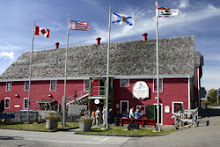Hello Everyone,
As I’ve mentioned before, we might have a tendency to mock those who faithfully follow superstitions related to the sea, but we should have more respect for them. Especially in the years before ship-to-shore communication, the stress of living and working within a fishing community was profound. People were determined to be as positive as they could be, since fishing was the only way of life available to them, but the very real dangers that were faced daily could not be ignored.
One of the ways in which many mariners and their families felt that they had some control over their lives came in the form of superstitions.
One superstition focused on the colour of mittens worn by fishermen.
Home-made mittens were used by both inshore and offshore fishermen. The women in the families would often knit thick, large wool mittens for their loved ones. The mittens would shrink from the cold Atlantic waters, and would become almost water-tight.
In Nova Scotia, the mittens were often made of white wool. Mittens with any colour were thought to bring bad luck. There is a story told of one captain of a fishing schooner who, after discovering that a member of the crew had brought grey mittens with him, turned the schooner around and returned to port. The offending mittens were removed from the vessel. There are many other stories where coloured mittens were thrown overboard.
Why was the colour of mittens important? Undertakers often wore gloves that were grey. A connection was made that coloured gloves and mittens were harbingers of death.
It was only a small part of life aboard a fishing schooner, like the Museum’s Theresa E. Connor, but it was important. It helped to give a sense of comfort, to both the men at sea and their families at home. Fishermen’s mittens are made on site at the Fisheries Museum of the Atlantic, here in Lunenburg, Nova Scotia.
Wishing you Smooth Sailing,
Heather
Subscribe to:
Post Comments (Atom)

No comments:
Post a Comment